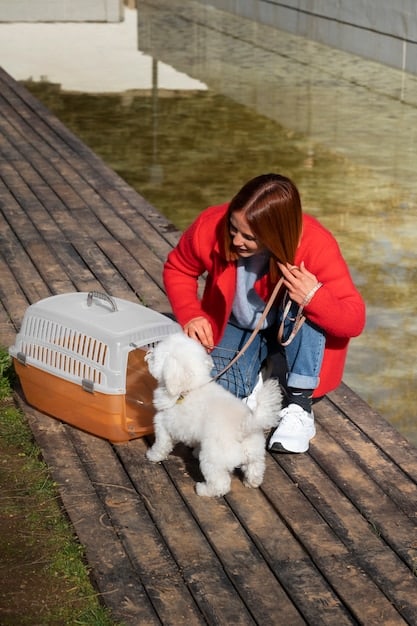Is Your Pet Carrier Safe? 2025 Reviews & Safety Standards

Ensuring your pet carrier meets the latest safety standards is crucial for their well-being during travel; this 2025 review explores key features, regulations, and innovative designs to help you choose a carrier that prioritizes your pet’s safety and comfort.
Traveling with your beloved pet should be a joyful experience, not a stressful one. A key component of ensuring a smooth and safe journey is selecting the right pet carrier. But is your pet carrier safe? 2025 Reviews and Safety Standards are evolving, so let’s dive into what makes a pet carrier truly safe and reliable for your furry friend.
Understanding Pet Carrier Safety Standards in 2025
Pet travel has become increasingly common, leading to heightened awareness and stricter regulations surrounding pet carrier safety. Understanding these standards is the first step in ensuring your pet’s well-being during transit.
Evolving Regulations
Safety standards for pet carriers are not static; they evolve with research, technology, and a growing understanding of animal welfare. Several organizations and regulatory bodies play a role in setting these standards.
- IATA (International Air Transport Association): Sets guidelines for carriers used in air travel, focusing on ventilation, size, and construction to ensure animal comfort and safety.
- USDA (United States Department of Agriculture): While not specific to carriers, the USDA regulates animal welfare during transport, influencing carrier design and usage.
- ASTM International: Develops voluntary standards for pet products, including carriers, focusing on material safety, structural integrity, and ease of use.
Key Safety Features to Look For
When evaluating a pet carrier, consider these essential safety features. These features not only ensure your pet’s physical safety but also contribute to their overall comfort during travel.
- Ventilation: Adequate airflow is crucial to prevent overheating and ensure your pet breathes comfortably. Carriers should have multiple well-placed ventilation openings.
- Secure Latches: Latches must be sturdy and reliable to prevent accidental openings. Look for latches that are difficult for pets to manipulate.
- Durable Construction: The carrier should be made from materials that can withstand the rigors of travel. Strong frames and tear-resistant fabrics are essential.
- Proper Sizing: The carrier should be large enough for your pet to stand, turn around, and lie down comfortably. Overcrowding can lead to stress and injury.
Understanding the safety standards and key features will help you make an informed decision when choosing a pet carrier, ensuring your furry friend travels safely and comfortably in 2025.
Top Pet Carrier Reviews for 2025
Navigating the market for pet carriers can be overwhelming, with countless brands and models available. Here, we review some of the top-rated pet carriers for 2025, highlighting their strengths and weaknesses to help you find the perfect fit for your pet.

Soft-Sided Carriers
Soft-sided carriers are popular for their lightweight design and flexibility. They are often made from fabric and feature mesh windows for ventilation.
- Pros: Lightweight, easy to store, comfortable for pets.
- Cons: Less durable than hard-sided carriers, may not be suitable for larger pets.
Hard-Sided Carriers
Hard-sided carriers offer greater protection and durability, making them ideal for air travel and longer journeys.
- Pros: Sturdy, provides excellent protection, suitable for various modes of transport.
- Cons: Heavier, less flexible, may take up more storage space.
Innovative Designs
In recent years, there has been a rise in innovative pet carrier designs that prioritize both safety and convenience. These carriers often incorporate unique features to enhance the travel experience for both pets and owners.
Choosing the right pet carrier involves considering your pet’s size, temperament, and the type of travel you plan to undertake. By reviewing top-rated models and understanding their pros and cons, you can make an informed decision that ensures your pet’s safety and comfort.
How to Choose the Right Size Pet Carrier?
Selecting the appropriate size pet carrier is paramount to your pet’s comfort and safety. An ill-fitting carrier can cause unnecessary stress, discomfort, and even injury during travel. Here’s how to ensure you get the right size.
Measuring Your Pet
Before purchasing a pet carrier, accurately measure your pet. This will help you determine the ideal carrier dimensions to allow them to stand, turn around, and lie down comfortably.
- Length: Measure your pet from the tip of their nose to the base of their tail.
- Height: Measure your pet from the top of their head (or ears, whichever is higher) to the ground.
Carrier Dimensions
When comparing carrier dimensions, ensure they exceed your pet’s measurements. A general guideline is to add a few inches to both the length and height to provide ample space.
Remember, the right size pet carrier is not just about meeting minimum requirements; it’s about creating a comfortable and stress-free travel environment for your beloved companion. Take the time to measure accurately and consider your pet’s unique needs when selecting a carrier size.
Ensuring Proper Ventilation in Your Pet Carrier
Proper ventilation is a critical aspect of pet carrier safety that often goes overlooked. Without adequate airflow, your pet can suffer from overheating, dehydration, and respiratory distress, especially during long journeys or in warm weather.

Importance of Airflow
Adequate airflow helps regulate your pet’s body temperature, ensuring they remain comfortable and safe. This is especially crucial in enclosed spaces where temperature can rise quickly.
Carrier Ventilation Design
The design of the ventilation system plays a significant role in its effectiveness. Look for carriers with multiple ventilation openings strategically placed to maximize airflow.
- Mesh Windows: These provide excellent airflow while allowing your pet to see their surroundings.
- Air Holes: Smaller holes distributed around the carrier can supplement mesh windows and ensure air circulation.
- Placement: Ventilation openings should be placed at different levels to facilitate the movement of air.
Prioritizing proper ventilation in your pet carrier is a simple yet effective way to safeguard your pet’s health and well-being during travel. By understanding the importance of airflow and choosing a carrier with a well-designed ventilation system, you can ensure your pet stays comfortable and breathes easy, no matter the journey.
The Role of Secure Latches and Locks in Pet Carrier Safety
Secure latches and locks are fundamental to pet carrier safety. These mechanisms prevent accidental openings, ensuring your pet remains safely contained during travel. Here’s what to look for in a reliable latching system.
Latch Design
The design of the latches should be both secure and user-friendly. Latches that are too complex can be difficult to operate quickly in emergency situations.
- Spring-Loaded Latches: These automatically lock into place, providing a secure closure that resists accidental openings.
- Double-Locking Mechanisms: These require two separate actions to open, further reducing the risk of accidental release.
Material and Durability
The material used to construct the latches is crucial. Durable materials like metal or high-impact plastic are less likely to break or fail under stress.
Investing in a pet carrier with secure latches and locks is an investment in your pet’s safety. By considering latch design, material durability, and placement, you can choose a carrier that provides peace of mind and ensures your furry friend remains safely contained throughout your travels.
Maintaining and Inspecting Your Pet Carrier for Optimal Safety
Regular maintenance and inspection of your pet carrier are essential to ensure its safety and longevity. Over time, wear and tear can compromise the carrier’s structural integrity and safety features. Here’s how to keep your pet carrier in top condition.
Regular Cleaning
Regular cleaning not only keeps the carrier hygienic but also allows you to spot potential issues early on. Use mild soap and water to clean the carrier interior and exterior.
Hardware Inspection
Inspect latches, hinges, and handles for signs of wear or damage. Replace any broken or damaged parts immediately.
- Check Latches: Ensure they latch securely and are free from rust or corrosion.
- Inspect Handles: Make sure they are firmly attached and can support the weight of the carrier and your pet.
- Examine Hinges: Look for signs of wear or damage that could compromise their functionality.
Fabric and Frame Assessment
For soft-sided carriers, check the fabric for tears, fraying, or weakened seams. For hard-sided carriers, inspect the frame for cracks or structural damage.
By establishing a routine of regular maintenance and inspection, you can ensure your pet carrier remains a safe and reliable travel companion for years to come. Addressing minor issues promptly can prevent them from escalating into major safety hazards, giving you peace of mind and keeping your pet protected.
| Key Point | Brief Description |
|---|---|
| 📏 Proper Sizing | Ensure carrier allows pet to stand, turn, and lie down comfortably. |
| 💨 Ventilation | Adequate airflow prevents overheating and respiratory issues. |
| 🔒 Secure Latches | Latches and locks prevent accidental openings during travel. |
| 🛠️ Maintenance | Regularly inspect and clean carrier to ensure safety and longevity. |
Is Your Pet Carrier Safe? FAQs
▼
The most vital features include adequate ventilation, secure latches, durable construction, and appropriate sizing for your pet to stand, turn, and lie down comfortably.
▼
Measure your pet from the tip of their nose to the base of their tail for length and from the top of their head or ears to the ground for height. Add a few inches to these measurements for carrier dimensions.
▼
Soft-sided carriers are lightweight and easy to store, but less durable. Hard-sided carriers offer greater protection and are suitable for air travel but can be heavier.
▼
Look for carriers with multiple mesh windows and strategically placed air holes to maximize airflow and prevent overheating, ensuring your pet breathes easy during travel.
▼
Inspect your pet carrier regularly, ideally before each trip, checking latches, hinges, handles, fabric, and frame for signs of wear or damage to ensure optimal safety.
Conclusion
Choosing a safe pet carrier involves understanding current safety standards, reviewing available options, and regularly maintaining the carrier. Prioritizing ventilation, secure latches, appropriate sizing, and durable construction will ensure your pet travels comfortably and safely. Remember, a well-chosen and maintained pet carrier contributes significantly to a stress-free journey for both you and your furry friend.





